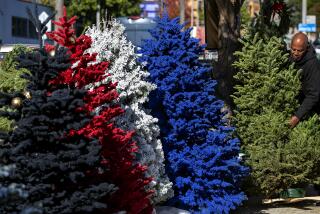Condition of Ornaments May Tell Age
Question: We have kept some Christmas tree ornaments in our family for a couple of generations. I think they came from Germany. Well, it’s that time of year again, and we wondered what suggestions you might have for refurbishing these old collectible ornaments before putting them back atop our tree.--R.A.
Answer: Keep your cleaning effort relatively simple. Usually a dry, soft cloth will do the job. Collectors warn that you shouldn’t attempt to wash tree ornaments, because water would almost certainly damage the lacquer that coats many of the old decorations.
Moreover, some collectors can determine the age of tree ornaments by analyzing the condition of lacquered surfaces. Thus, washing off the lacquer will make it more difficult to date ornaments.
Authentic Appearance
So don’t try to scrub or patch old ornaments--the older and more authentic their appearance, the more valuable they are to collectors.
If you are interested in determining the age of some of the items in your collection, patina, design and construction of the ornament tell experienced collectors a lot.
For example, glass balls decorated with wire tinsel or silk tassels would probably have been produced around the turn of the century. And if you have ornaments that are topped with a metal cap pierced with a hole so that it can be fastened to a tree, then they probably were produced before World War I.
The earliest Christmas tree ornaments were handmade in Europe and appear to have been used first in this country by the Pennsylvania Dutch in the 1860s.
Then, by the turn of the century, demand for ornaments increased to the point that several areas in Germany and Czechoslovakia became centers for ornament design and production.
Some of this country’s biggest retail outlets, like Sears and Woolworth, acted as U.S. distributors.
Most of the early ornaments were of relatively simple design. Perhaps the most valuable of them were those made in Dresden, Germany, and were made of rugged, embossed cardboard and covered with metallic paper. Now, Dresden ornaments are considered extremely scarce, part of the reason being that by the turn of the century they were generally replaced by blown-glass ornaments, a process that is used even today.
Like snowflakes, hardly any two collectible Christmas tree ornaments seem alike. Pre-World War I ornaments have been decorated with everything from cotton to buttons and glass, and many have embossed paper faces. Likewise, their prices appear to be all over the lot as well; a recently published catalogue listed a range from under $10 to above $200 for individual ornament items.
Collectors should be aware that light-bulb ornaments are in demand as well.
It appears that the first tree bulbs were designed and painted in Vienna around the turn of the century. And like their valuable ornament counterparts, they can be very delicate and just as intricately shaped into flowers, animals and the like. After World War I, such bulbs were being mass produced by Japanese and American firms, including General Electric in this country.
Miniature Trains
On a related note, it’s not unusual to view a decorated Christmas tree surrounded by tracks and miniature trains. This coming weekend in New York, Christie’s, the auction house, will be selling the large toy train collection of Charles W. Gasque of Columbia, S.C., who died this past spring.
Included in this 4,000-item collection are American and European train models produced by firms such as Lionel, American Flyer, Boucher, Ives and Voltamp. According to Christie’s, prices should range from $100 to $150 for a Hafer streamlined diesel locomotive and three additional coach-observation cars, to $10,000 to $12,000 for a set of Lionel’s standard-gauge locomotive and state cars, dating back to 1929.
Toy trains were produced by German firms as far back as the 1890s. Then, Carlisle & Fine of Cincinnati began making them on this side of the Atlantic around 1900. New York City-based Lionel also entered the field at about this time, its popular trains created by inventor Joshua Lionel Cowan. American Flyer, founded in 1907 by Chicago businessman W. F. Hafer, became Lionel’s main competitor.
Q: How expensive are original Walt Disney Mickey Mouse cels?--R.P.
A: They’re very popular and demand is almost never lacking. So it’s not unusual to see auction prices as high as $2,000 and $3,000 or more for a single cel if it’s in good condition.
As a result of a recent column on where to look for ground-floor collectible opportunities, a reader reminds us that nautical collectibles can still be found at relatively low prices if one knows where to look.
For example, T.R. of Los Angeles says ship salvage yards still produce items that might need little restoration before becoming an important part of a collection. So you might want to browse through the salvage yards for a new hobby.
Ronald L. Soble cannot answer mail personally but will respond in this column to questions of general interest about collectibles. Do not telephone. Write to Your Collectibles, You section, The Times, Times Mirror Square, Los Angeles 90053.


